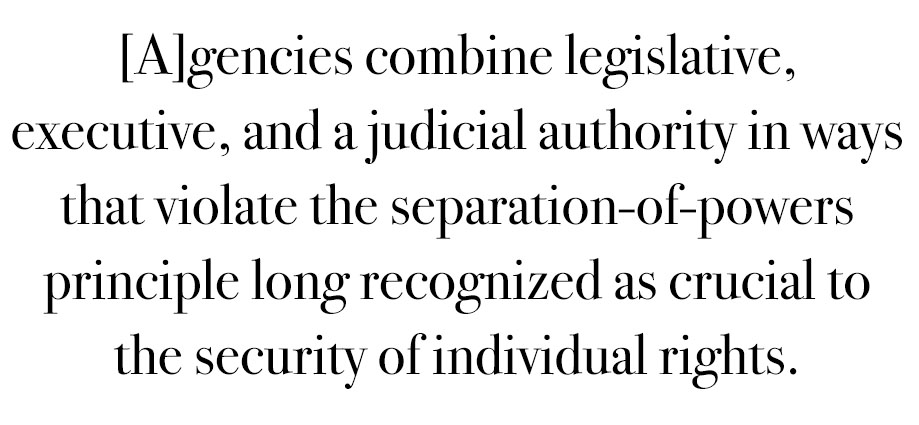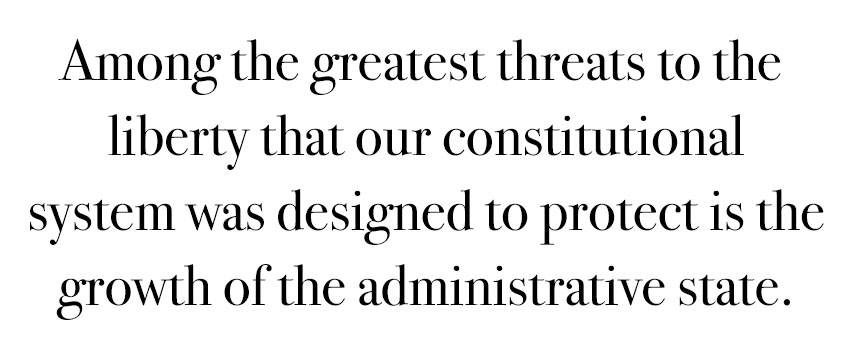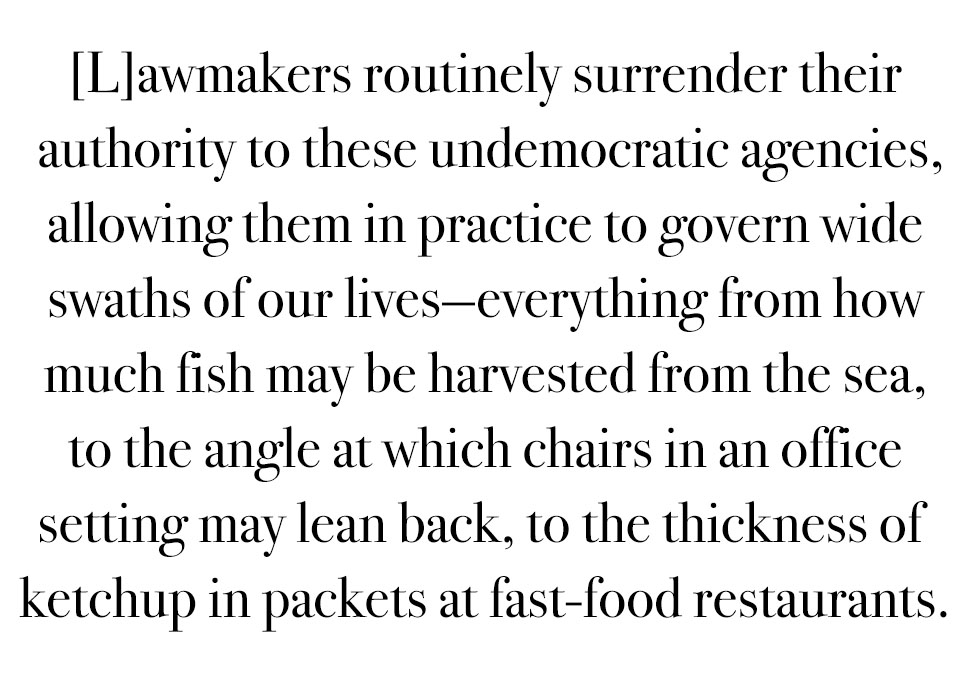End Notes
1Philip Hamburger, Is Administrative Law Unlawful? (Chicago: University of Chicago Press, 2014), 509.
2John Marini and Ken Masugi, Unmasking the Administrative State: The Crisis of American Politics in the Twenty-First Century (New York: Encounter Books, 2019).
3295 U.S. 602 (1935).
4Id. at 629.
5Id. at 624, 628.
6Geoffrey P. Miller, “Independent Agencies,” Supreme Court Review 1986: 44.
7Richard G. Niemi & Joshua J. Dyck, Guide to State Politics and Policy (Washington, D.C.: CQ Press, 2013), 248.
8Mass. Gen. Laws ch. 7, § 4A(a).
9Ca. Gov. Code § 9148.50 et seq. requires periodic review of state agencies, but unlike true “sunsetting,” the elimination of an agency is not accompanied by an elimination of its powers.
10See Adam Thierer, “Regulatory Capture: What the Experts Have Found,” Technology Liberation Front, December 19, 2010, https://techliberation.com/2010/12/19/regulatory-capture-what-the-experts-have-found/.
11See, e.g., North Carolina State Bd. of Dental Examiners v. FTC, 574 U.S. 494 (2015).
122 Public Papers of the Presidents: Ronald Reagan 1988-1989 (Washington, D.C.: Government Printing Office, 1991), 1610.
13Marine Forests Soc’y v. California Coastal Com., 36 Cal. 4th 1, 25 (2005).
14Reg Stats, GW Columbian College of Arts & Sciences, https://regulatorystudies.columbian.gwu.edu/reg-stats.
15Patrick McLaughlin, “Comparing Regulations Across U.S. States,” Mercatus Center, August 7, 2018, https:// www.mercatus.org/publications/regulation/comparing-regulations-across-us-states
16See, e.g., Sackett v. EPA, 566 U.S. 120 (2012).
17Chevron, U.S.A., Inc. v. Nat. Res. Def. Council, Inc., 467 U.S. 837, 843 (1984).
18Auer v. Robbins, 519 U.S. 452, 461 (1997).
19Gutierrez-Brizuela v. Lynch, 834 F.3d 1142, 1149 (10th Cir. 2016).
205 U.S.C. § 706.
21Pub. L. 79-404, 60 Stat. 237.
225 U.S.C. § 706.
23Marbury v. Madison, 5 U.S. 137, 177 (1803).
24Chevron, 467 U.S. at 844.
25Encino Motorcars, LLC v. Navarro, 136 S. Ct. 2117, 2125 (2016).
26Gutierrez-Brizuela, 834 F.3d at 1152.
27Auer, 519 U.S. at 461.
28In the 2019 term, the Supreme Court heard Kisor v. Wilkie, a case that, among other things, asked the Justices to overrule Auer deference. There, the Court arguably modified how Auer deference works—but declined to overrule it. 139 S. Ct. 2400, 2423 (2019).
29Flytenow, Inc. v. F.A.A., 808 F.3d 882, 890 (D.C. Cir. 2015).
30See, e.g., QCC, Inc. v. Hall, 757 So. 2d 1115, 1117 (Ala. 2000); Bell Atl. Mobile, Inc. v. Dep’t of Pub. Util. Control, 754 A.2d 128 (Conn. 2000); In re Water Use Permit Applications, 94 Hawai’i 97, 144-145 (2000); Canty v. Idaho State Tax Com’n, 59 P.3d 983, 988-989 (2002); People ex rel. Birkett v. City of Chicago, 779 N.E.2d 875, 881 (2002); Reifschneider v. State, 17 P.3d 907, 913 (2001); Davis v. State Bd. of Certified Public Accountants of Louisiana, 131 So.3d 391, 399 (2013); Maryland Aviation Admin. V. Noland, 386 Md. 556, 572 (2005); Project Extra Mile v. Nebraska Liquor Control Com’n, 283 Neb. 379, 395 (2012); In re Town of Sebrook, 44 A.3d 518, 524-525 (2012); TAC Associates v. New Jersey Dept. of Environmental Protection, 202 N.J. 533, 541-542 (2010); Lorillard Tobacco Co. v. Roth, 786 N.E.2d 7, 10 (2003); North Carolina Acupuncture Licensing Board v. North Carolina Board of Physical Therapy Examiners, 821 S.E.2d 376, 379-380 (2018); Industrial Contractors Inc., v. Workforce Safety & Insurance, 772 N.W.2d 582, 585 (2009); In re Protest of Betts Telecom Oklahoma, Inc., 178 P.3d 197, 199 (2008); Seeton v. Pennsylvania Game Com’n, 594 Pa. 563, 578 (2007); In re Williston Inn Group, 949 A.2d 1073, 1077 (2008).
31Hamburger, The Administrative State, 43.
32William Yeatman, “An Empirical Defense of Auer Step Zero,” Georgetown Law Journal, 106, no. 2, (2018): 515, 545 (finding that government agencies won 78% of cases from 1993-2006, when Auer deference was most permissive compared to 71% of cases after 2006, when the Supreme Court began to limit that deference doctrine).
33Although in recent years, some states have begun scaling this back. The Wisconsin and Mississippi Supreme Courts issued decisions in 2018 that repudiated their versions of Chevron deference. Tetra Tech EC, Inc. v. Wisconsin Dep’t of Revenue, 382 Wis. 2d 496, 564 (2018); King v. Mississippi Military Dep’t, 245 So. 3d 404, 407-08 (Miss. 2018). Deferring to the legal interpretations of agencies, declared the Wisconsin justices, “is unsound in principle” because it “does not respect the separation of powers, gives insufficient consideration to the parties’ due process interest in a neutral and independent judiciary, and ‘risks perpetuating erroneous declarations of the law.’” Id. Their Mississippi colleagues agreed: “Deferential review of executive-branch statutory interpretations,” they said, conflicts with the state constitution’s “strict constitutional separation of powers. … [I]n deciding no longer to give deference to agency interpretations, we step fully into the role the [Mississippi Constitution] provides for the courts and the courts alone, to interpret statutes.” Id.
345 U.S.C. § 706.
35Colo. Rev. Stat. § 24-4-106; Conn. Gen. Stat. § 4-183; D.C. Code § 2-510; Ga. Code § 50-13-19; Haw. Rev. Stat. § 91-14; Idaho Code § 67-5279; Ind. Code § 4-21.5-5-14; Iowa Code § 17A.19; Kan. Stat. § 77-621; Ky. Rev. Stat. § 13B.150; La. Rev. Stat. § 49:964; Me. Rev. Stat. tit. 5, § 11007; Md. Code, State Gov’t § 10-222; Mass. Gen. Laws ch. 30A, § 14; Mich. Comp. Laws § 24.306; Mo. Rev. Stat. § 536.140; Mont. Code § 2-4-704; Neb. Rev. Stat. § 84-917; Nev. Rev. Stat. § 233B.135; N.C. Gen. Stat. §§ 150B-43, 150B-51; N.D. Cent. Code §§ 28-32-46, 28-32-47; R.I. Gen. Laws § 42-35-15; S.C. Code § 1-23-380; Tenn. Code § 4-5-322; Tex. Gov’t Code §§ 2001.172, 2001.174; Utah Code § 63G-4-403; Wash. Rev. Code § 34.05.570; W. Va. Code § 29A-5-4.
36A.R.S. § 12-910(E).
37See, e.g., JH2K I LLC v. Arizona Dep’t of Health Servs., 246 Ariz. 307, 310 (Ct. App. 2019).
38The Separation of Powers Act of 2016, 114th Cong., 2d Session, available at https://www.grassley.senate. gov/sites/default/files/judiciary/upload/Regs%2C%2003-18-16%2C%20Separation%20of%20Powers%20 Restoration%20Act%20Bill%20Text.pdf.
39Nebbia v. New York, 291 U.S. 502 (1934).
40FCC v. Beach Communications, 508 U.S. 307, 318 (1993).
41Timothy Sandefur, “Disputing the Dogma of Deference,” Texas Review of Law & Politics 18, no. 1 (Fall 2013): 121.
42Hettinga v. United States, 677 F.3d 471, 482–83 (D.C. Cir. 2012) (Brown & Sentelle, JJ., concurring).
43Patel v. Texas Dep’t of Licensing & Regulation, 469 S.W.3d 69, 98 (Tex. 2015) (Willett, J., concurring).
44State v. Lupo, 984 So. 2d 395, 408 (Ala. 2007) (Parker, J., concurring).
45Dick Carpenter and Lisa Knepper, License to Work: A National Study of Burdens from Occupational Licensing, 2nd ed. (Institute for Justice, 2017), 6, https://ij.org/wp-content/themes/ijorg/images/ltw2/License_ to_Work_2nd_Edition.pdf.
46Mark Flatten, Protection Racket: Occupational Licensing Laws and the Right to Earn a Living, Goldwater Institute, December 6, 2017, https://www.goldwaterinstitute.org/article/protection-racket-occupational-licensing-laws- and/.
47Vt. Stat. Ann. tit. 20, § 2731, et seq.
48W. Va. Code Ann. § 47-1A-7.
49Id. at § 3:3808.
50Ariz. Rev. Stat. Ann. § 41-1093, et seq.
51Angela Gonzales, “Goldwater Institute Helps Behavioral Health Counselor Continue Practicing in Arizona,” Phoenix Business Journal, November 7, 2017, https://www.bizjournals.com/phoenix/news/2017/11/07/ goldwater-institute-helps-behavioral-health.html.
52H.B. 2569 (2019), codified at A.R.S. § 32-4302.
53S.B. 1401, codified at A.R.S. § 32-506.
54Several states already have laws whereby an application for a permit is deemed approved if a licensing agency fails to act on it within a specified amount of time. See, e.g., HI St. § 91-13.5; Minn. Stat. § 15.99. Such laws are usually confined to certain narrowly limited classes of cases and are sometimes weakened by certain procedural requirements. But they provide a useful tool for protecting individuals against agency abuses while also creating a valuable incentive for agencies to act promptly rather than employ expensive and oppressive delaying tactics. See Nick Dranias, “The Local Liberty Charter: Restoring Grassroots Liberty to Restrain Cities Gone Wild,” Phoenix Law Review 3, no 113 (2010): 157
55Freedman v. Maryland, 380 U.S. 51, 58 (1965).
56Staub v. City of Baxley, 355 U.S. 313, 322 (1958).
57Brian Baugus and Feler Bose, “Sunsetting Government Waste,” U.S. News & World Report, September 1, 2015, https://www.usnews.com/opinion/economic-intelligence/2015/09/01/sunset-clauses-leads-to-political- power-plays-but-some-good-government.
58Idaho Stat. § 67-5292.
59James Freeman, “The Great Idaho Do-Over,” Wall Street Journal, May 16, 2019.
60Rhode Island Senate, RI S3015, 2016, Regular Session.
61James Broughel, “Release and Replace the Code of Federal Regulations,” Investor’s Business Daily, December 11, 2018.
62§ R3-12-303.
63§ R19-1-304.
64The Federalist, no. 47 (J. Cooke, ed., Middletown, CT: Wesleyan University Press, 1961), 324.












